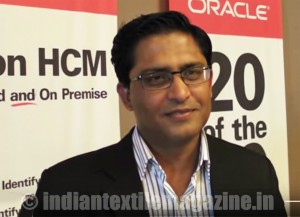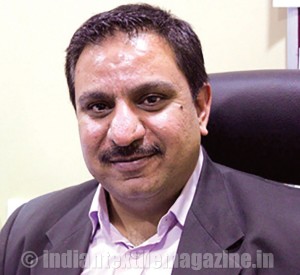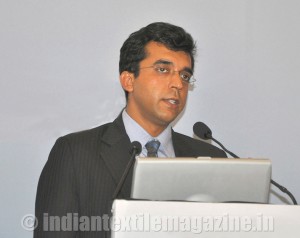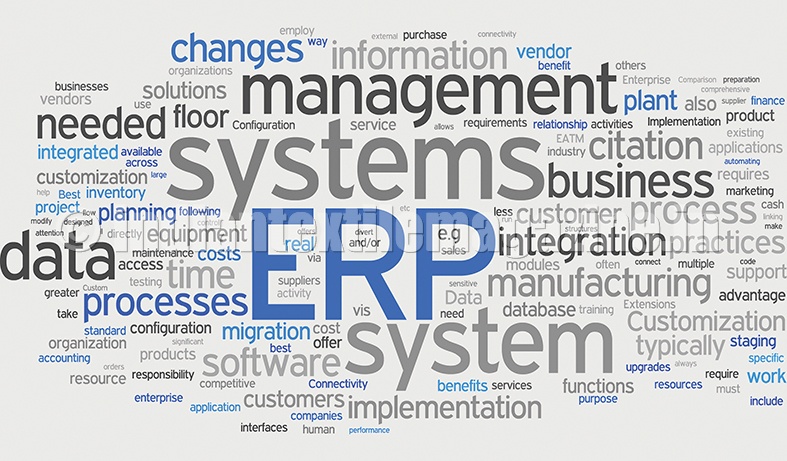Let’s retrace our steps to the New Millennium. Even at that time Welspun India, a home textiles company, had already understood that IT had the power to reshape and revolutionize the way business is carried out. The company took its early steps into IT by implementing SAP in 2000. “IT has been the keystone for designing of our internal processes. This focus on IT has resulted in thought processes like automation, new and latest production technology and new IT applications,” said Mr. Rajesh R. Mandawewala, Managing Director, Welspun India Ltd.

The latest is HANA, SAP’s ERP suite. “With SAP’s Real-time platform of HANA, we are now embarking on a transformational journey by not only supercharging our existing transaction systems but also enabling real-time reporting through HANA Live,” he added.
Sharing other insights, he said that, as HANA offers speed and real time analytics, it will result in better control of the production processes and therefore reduce quality issues. It will also enable better planning of manufacturing resources and better tracking of the product across the manufacturing life cycle, amongst other benefits.
Just-in-time (JIT) delivery by vendors is another big advantage that Welspun is planning to achieve with HANA. The real time data will give vendors the ability to forecast the demands of the production lines and therefore deliver JIT.

Finally, with SAP’s Simple Finance as a part of the new S/4 HANA Suite, the company is planning to review some of its core financial processes.
Welspun India is an early IT entrant, but today be it the large textile players or SMBs, everyone in the textile space has already adapted to IT. The latest from the IT platform is ERP, an acronym for enterprise resource planning.
It is no exaggeration to say that the warp and the weft of textiles are now intertwined with ERP. Join me on this journey as textile brands shrug off slow processes and reinvent the wheel with ERP.
The textile industry holds promise for IT folks who have tailored solutions for them. “An ERP which can understand the typical textile requirements and provide a technologically advanced platform to be effectively used by end users, IT users and management is the key to better Business Performance,” said Mr. Rahul Mahajan, Business Development Manager of Infinite.

The textile industry is a unique manufacturing industry with many complexities. The manufacturing lifecycle is very short and product variability is huge. The number of parameters that can alter the output is vast, ranging from raw material and labour to machinery set-ups.
“Organizations should adopt ERP ‘tailor made’ for the textile industry rather than ERP ‘modified’ for the industry. Another important aspect is flexibility to manage the full supply chain along with daily business changes,” felt Mr. Mahajan. On the technology front, the ERP should be future enabled. It should have the capability of on premise or on cloud deployment while ensuring security and guaranteed accessibility.
Wikipedia describes ERP as business management software comprising integrated applications which can be used to collect, store, manage and interpret data from various business activities. As Mr. Hirak Kayal, Vice President, Outbound Applications Product Management, Oracle India, puts it: “A well-integrated ERP system which is scalable, modern and complete is needed to heighten quality, to make profit and to survive in the global market as it enables you to think on the results and allows you to make any corrections well within time.”
ERP, a tech enabler
Technology, be it cloud or big data, has been an enabler to the textile industry. ERP is the latest tech solution which has caught the attention of textile companies. And for the right reasons. “The textile industry varies from many other manufacturing industries in terms of labour, capital, energy, R&D and trade intensity. Additionally, the introduction of online retailing and adoption of fast fashion models have added additional pressure on the industry to address the changing business dynamics with utmost efficiency and effectiveness,” reasoned Mr. Amit Gugnani, Sr. Vice President, Fashion Division of Technopak, India’s leading management consulting firm with more than 20 years of experience in working with organizations across consumer goods and services.

Consequently, the application of software packages in the industry has transgressed the boundaries of core accounting functions to the entire business activities, including ERP. The industry is expected to continue to leverage the benefits offered by ERP in terms of visibility of all the crucial functions of various departments, real time data access, ease of flow tracking and up-to-date reporting system.
“The $99 billion Indian textiles and apparel industry is expected to grow at a compounded annual growth rate (CAGR) of 9% over the next decade owing to increase in domestic demand and sustained competitiveness of India in the global exports markets,” added Mr. Gugnani.
Considering the increasing global nature of the textile industry and the growing pressure to reduce lead time and improve supply chain efficiency, the application of ERP packages in textiles has gained momentum in the last decade. “The importance of an ERP system in the textile industry is derived from the fact that due to ever increasing competition and pressure on margins, it is imperative that the industry looks to improve its overall efficiencies,” felt Mr. Rohit Pandit, Director, Intex Consulting Group | VTMtex Virtual Textile Mill India (P) Ltd.

He added: “ERP systems, especially those designed specifically for the textile industry and those which are also able to offer value-added consulting services in the form of process improvement suggestions with the ERP, will provide lots of areas for increasing the organization efficiencies.”
Of course, even as we stretch the yarn to absorb ERP solutions, there are challenges to be addressed. ERP, it appears, cannot function in isolation. This line of thinking is supported by the fact that the company should have a consulting ability to transfer improvement suggestions and knowledge along with ERP implementation. A lot depends on whether the textile player wants to invest in a high end system and scale it up gradually as they reap the benefits and gain the experience. It requires a delicate balance between ERP investments vis-à-vis the kind of stability, domain knowledge, consulting experience, functions/features, and long-term support and consistent enhancement of the ERP system. All these factors have a direct bearing on the kind of implementation experience that the textile company will have.
Nevertheless, with ERP, almost always processes can be scaled up. “When you look at yarn dyeing, ERP helps in reduction of the dyeing costs and of the production cycle. In the case of weaving or tufting, it helps increase the efficiency of the loom shed,” Mr. Pandit said, and added, “ERP also helps reduce the downtime because of organizational reasons like missing material.” With ERP, one can expect visible accountability and do away with misutilization of resources.

Talking of specifics, ERP helps optimize weaving planning based on parameters like picks per inch, reed width, RPM of the looms, fabric quality and the kind of loom. It also reduces costs by providing tools to compare rates of various vendors before finalizing a vendor for purchase order of materials.
These functions have clicked with the industry. A case in point is Ganga Acrowools Ltd., a Ludhiana-based company with expertise in worsted acrylic yarns, wool yarns or blended yarns, both greige and dyed. It has integrated ERP solutions into the system. Ironically the inspiration came with the need to establish a system to address the very complex nature of the textile business that has many variations and endless possibilities, from the raw material to the final product stage.
The other main reasons were the impatient customers demanding access to information, getting hold of historical records and integrating all departments on one single platform. The answer to all these functions has been provided by ERP solutions, through the implementation of the INTEX ERP – the integrated and innovative ERP-Business-Suite software for textile manufacturers – provided through the Indian subsidiary of Intex Consulting Gmbh of Germany.
Since then, the overall costs and inventory levels have reduced, overall inventory management has improved, errors have reduced drastically and sales analysis has become easier. There are various other improvement areas/benefits which have accrued to Ganga with the implementation, like the system-enabled production planning procedures, real time data access, the systematic textile product developments structures and data validations in the Intex system.
While these are tangible, ERP has also offered intangible benefits. “ERP lowered the stress level of employees, reduced manual work and improved inter-departmental relations between the dyeing and marketing professionals or the stores and purchase professionals,” said Mr. Amit Thapar, Commercial President, Ganga Acrowools Ltd., Ludhiana. “When we started ERP implementation, we grew from Rs. 60 crores to over Rs. 280 crores plus. I cannot think of this growth without ERP which was a catalyst and helped streamline the processes.”
Cloud-ERP, a vantage point
Companies have oriented themselves to this growing demand and have tailored ERP solutions for the textile industry. As in the case of Krisol Infosoft Private Ltd., an eight-year-old company that brings the latest technology to the Indian SME sector. Krisol ERP solutions are available for different business verticals, including textiles. “ERP is a very important and integral part of the textile industry. Planning-to-execution and labour management ERP would provide the perfect insights required, once data points are present in the ERP system. It decreases the cost of paper and stationery with digital data practices and lowers postage costs,” highlighted Mr. Kaushik Rajagopal, CEO, Krisol Infosoft Private Ltd.
The KrisolTex ERP gives insights into better planning across processes to the management, supervisors of each process and quality control with C Grade and damage analysis at various stages of different process. The ERP is a cloud-based system that allows marketing personnel to update new orders on real-time basis. The management can ramp up capacity planning and take informed decisions, from raw material to order completion, thereby reducing the lead time at the various levels of communication. This increases customer satisfaction levels with timely delivery. This is one of the key factors to ensure success in the textile industry.
Digital Approval via KrisolTex ERP management enables the management to ensure smooth operations of the textile vendors even if they are off station.
ERP packages a host of goodies as it gives insights on cost cutting areas, increased process handover mechanisms and of defects and how it can be reduced seen in terms of expenditure caused by supply chain management, local purchase management and other cash expenses. “The Indian textile industry needs to compete with its global peers and has to make informed decisions on capacity planning, labour planning, increased machine efficiency, informed preventive servicing of machinery, thus reducing expenditure on spares and increasing production quality and reducing production costs,” explained Mr. Rajagopal.
ERP-SMB, a win-win situation
ERP on cloud offers many benefits to both large enterprises and to SMBs. “For large organisations it ensures the availability of robust, feature-rich ERP cloud applications from established and trusted enterprise software vendors. It offers ease of deployment and the pay per use model helps shift IT investments from the CAPEX to the OPEX to well aligned business benefits with predictable cash outflow,” explained Mr. Hirak Kayal, Vice President, Outbound Applications Product Management, Oracle India.
Cloud ERP also frees valuable resources from maintaining legacy software and infrastructure to focus on higher-value and innovation-driven activities. It enables quicker deployments leading to faster time to value and helps businesses free up resources for more strategic initiatives. Cloud also offers a more flexible and scalable solution to provide long-term support for growth and expansion of an enterprise.
“SMBs do not have to purchase expensive hardware and software to support the new systems and do not have to allocate dedicated personnel to maintain the infrastructure once it is in operation. They benefit from the availability of a complete integrated system that provides best practice business processes “out of the box” to streamline and optimize operations,” added Mr. Kayal.
SMB’s are also able to achieve better management/executive decision support and control by eliminating data silos and providing more effective analytics and reporting tools.
ERP-BI for optimum results
ERP has led the textile industry towards other functional aspects like Business Intelligence (BI), much required for textile industries to keep a balance between production and orders. BI helps collate data from the ERP and provides the output / dash board for the top management reporting / viewing purpose. The purpose of BI is to be able to quickly drill down to the problem areas.
Mr. Mahajan put things in perspective, and said: “BI is immensely important from the management perspective. Having loads of information is of no use if one cannot make business sense out of it. BI Solutions can be successfully used after the implementation of the base ERP for managing logistics and finance transaction in real time with accuracy.”
Agreeably BI is possible with ERP because ERP leads to implementation of standard operation procedures (SOPs) resulting in unifying operations. In the long term, increasing the OTIF (On-Time In-Full) by optimum utilization of resources is achieved by ERP. “Without ERP it is not possible to manage Business Operations on a single platform. Without ERP information islands are created within an organization. An ERP is imperative to any Textile Organization,” concluded Mr. Mahajan.
ERP at a glance
Brings seamless communication across departments
Reduces delay through automated purchase order processing
Gives scope to rate vendors according to quality, quantity, service and delivery
Lowers fabric wastage and reduces consumption of dyestuffs and chemicals
Facilitates precise backtracking and helps reduce the downtime caused by the material

